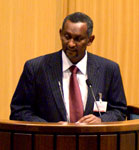
H.E. Eng. Maalim
“Regional integration, as we know, for most of our people may not mean much as a vocabulary” said Eng. Mahboub Maalim, addressing the 5th African World Business Congress and first IGAD Investment Forum 2009 held in Addis Ababa, last week.
“It is the operationalization of integration activities resulting in concrete tangible outcomes that will bring people on board,”
Under the theme of the “1st IGAD Investment Forum”, together with the fifth African World Business Congress, a large number of major International and Regional Organizations, Project Finance Organizations Banks, prominent CEOs and their representatives participated in the meeting. The forum brought together experts to brainstorm on topical issues in order to come up with useful recommendations, in addition to providing a platform for doing business in the IGAD region.
The IGAD region with population of 200 Million (3% of the global population) is the recipient of 40 percent of the entire global food aid, stated Eng. Maalim.
“The region has abundant resources, which when properly developed and tapped could propel its people to economic prosperity and, in particular the rich endowment of rivers, lakes and forests, the large livestock and high agricultural production potential,” the Executive Secretary said. “Other possible investment areas are: Building and Construction, Industry, Banking and Credit Sector and Tourism.”
Economic Integration as key to prosperity
The UN Under Secretary-General and Executive Secretary of the UN Economic Commission for Africa, Abdoulie Janneh, said that Africa’s development requires coherent action and closer integration of countries, which in turn calls for greater collaboration by all countries within specific sub-regions.
Urging member states to team up in order to improve their economies, Mr. Janneh said “for the business sector in Africa to grow and contribute to poverty reduction and economic development, domestic investment as a proportion of GDP must improve from an average 18% in Sub-Saharan Africa to between 25% and 30%, which is the average rate in East Asia ‘ he told the meeting.
Mr Janneh also called on the congress to look into the impact of this crisis on the fight against poverty and the on-going effort to achieve the Millennium Development Goals.
Explaining the future of IGAD’s future development, Eng. Maalim affirmed three possible scenarios:
1. An efficiently regionalized economic development providing the base for a common foreign and security policy; Concerted effort to complement integration efforts at national and regional level.
2. A hesitant preparedness to integrate with continues to be dampened by considerations of national interest and influence.
3. The negative scenario leaves the design of future of external and economic development relations decisively in decision-making share of bilateral state actors who, primarily oriented towards their own national interests, refuse common solutions or, when necessary, enter into temporary bilateral alliances for specific purposes.
“The key challenge, therefore, remains for all politicians and for all other integration advocates to constantly explain to all population groups in an open and transparent manner the practical advantages of a larger unified IGAD region in the present African and global environment,” said Eng. Maalim.
